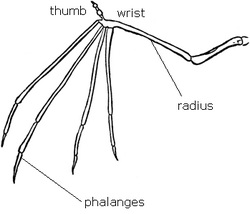Locomotion
Aerial Locomotion
Bats are the only mammals capable of flying. Their bones are light and their phalanges (digits) are lengthened to support wings. Some species have a long Radius bone in their forelimbs, which provides allows a wider range of rotation and flexibility.
Aerial Locomotion
Bats are the only mammals capable of flying. Their bones are light and their phalanges (digits) are lengthened to support wings. Some species have a long Radius bone in their forelimbs, which provides allows a wider range of rotation and flexibility.
Aquatic Locomotion
Swimmers have short front and hind limbs to create flippers. A streamlined body is necessary to propell them through water quickly and efficiently.
Terrestrial Locomotion
In terrestrial locomotion, most travel on four feet, although some such humans are bipedal. For balance, quadrupedals will keep three feet on the ground and bipedals will keep one foot on the ground while walking. Runners, or cursorials, need long, narrow bones for speed. Predators walk with all five digits, or toes, contacting the ground. This allows them to move quietly to stalk prey. Prey usually move on the tips of one to three digits. This gives them greater strides, therefore greater speed. Jumpers like kangaroos have strong hind limbs and a long tail to keep their balance. Many mammals alternate gaits. For example, horses can walk, trot, and gallop.
Scansorial/Arboreal
Climbers include tree squirrels and gibbons. Most of their life is spent living in trees. They either have claws or very long forelimbs.
Swimmers have short front and hind limbs to create flippers. A streamlined body is necessary to propell them through water quickly and efficiently.
Terrestrial Locomotion
In terrestrial locomotion, most travel on four feet, although some such humans are bipedal. For balance, quadrupedals will keep three feet on the ground and bipedals will keep one foot on the ground while walking. Runners, or cursorials, need long, narrow bones for speed. Predators walk with all five digits, or toes, contacting the ground. This allows them to move quietly to stalk prey. Prey usually move on the tips of one to three digits. This gives them greater strides, therefore greater speed. Jumpers like kangaroos have strong hind limbs and a long tail to keep their balance. Many mammals alternate gaits. For example, horses can walk, trot, and gallop.
Scansorial/Arboreal
Climbers include tree squirrels and gibbons. Most of their life is spent living in trees. They either have claws or very long forelimbs.

